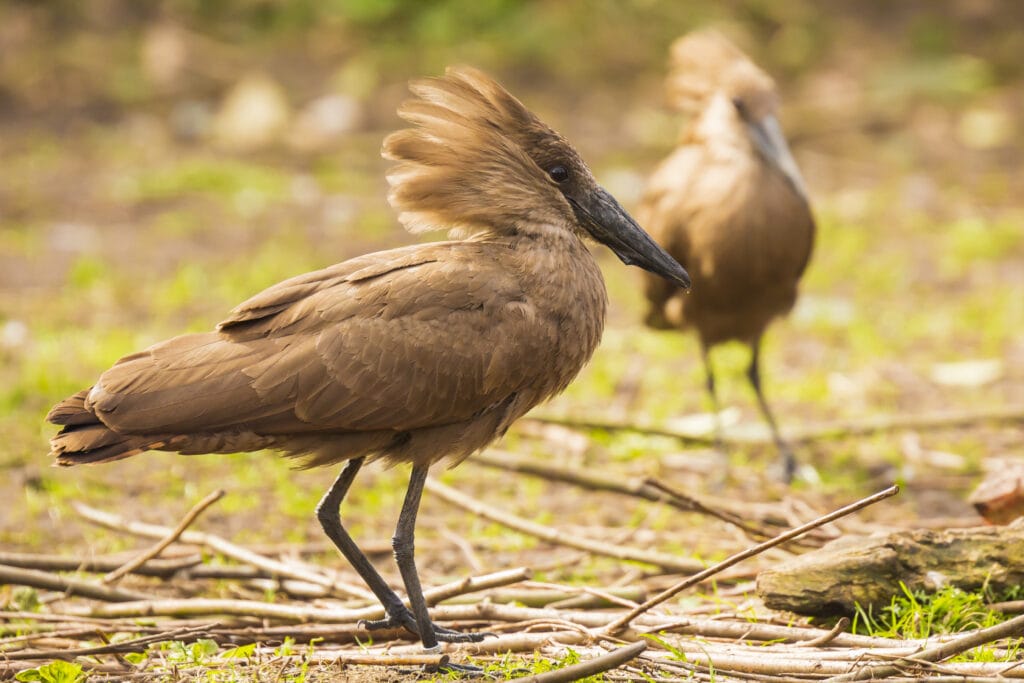The Hamerkop, sometimes spelled “Hammerkop,” is a unique wading bird occurring in sections of Africa south of the Sahara Desert, on the island of Madagascar, and in a coastal stretch of Arabia. Hamerkops are very distinctive-looking birds which seem to resemble Shoebill Storks, but on a much smaller and slimmer scale. This resemblance is no coincidence as the Hamerkop is said to be a relative of the Shoebill family as well as the pelican family.
Dinosaur-like, with a wide thick bill and long slender legs, the Hamerkop is known for constructing massive nests which are often large and stable enough to support the weight of a human. Hamerkops are the subject of superstition for both African and Arabian peoples as well as other cultures which have colonized regions of Hamerkop territory.
The Hamerkop’s distinctive appearance and apparent comfort in the presence of humans likely contributes to this bird’s significance as a supernatural symbol. In this article, we’ll look at the Hamerkop’s unique traits and the incredible cultural impact that this unusual bird has had on the peoples who interact with it.
Hamerkop Symbolism and Meaning
As mentioned previously, the Hamerkop is widely associated with a variety of superstitions and occult beliefs. The Hamerkop is often called the “Lightning Bird” thanks to a widespread African superstition which holds that people are struck by lightning as a punishment for tampering with Hamerkop nests. For this reason, the Hamerkop is associated with magic and paganism. Furthermore, the “Lightning Bird” belief firmly connects this bird with ideas like the protection and sanctity of the home as well as with natural disasters and calamity. (1)
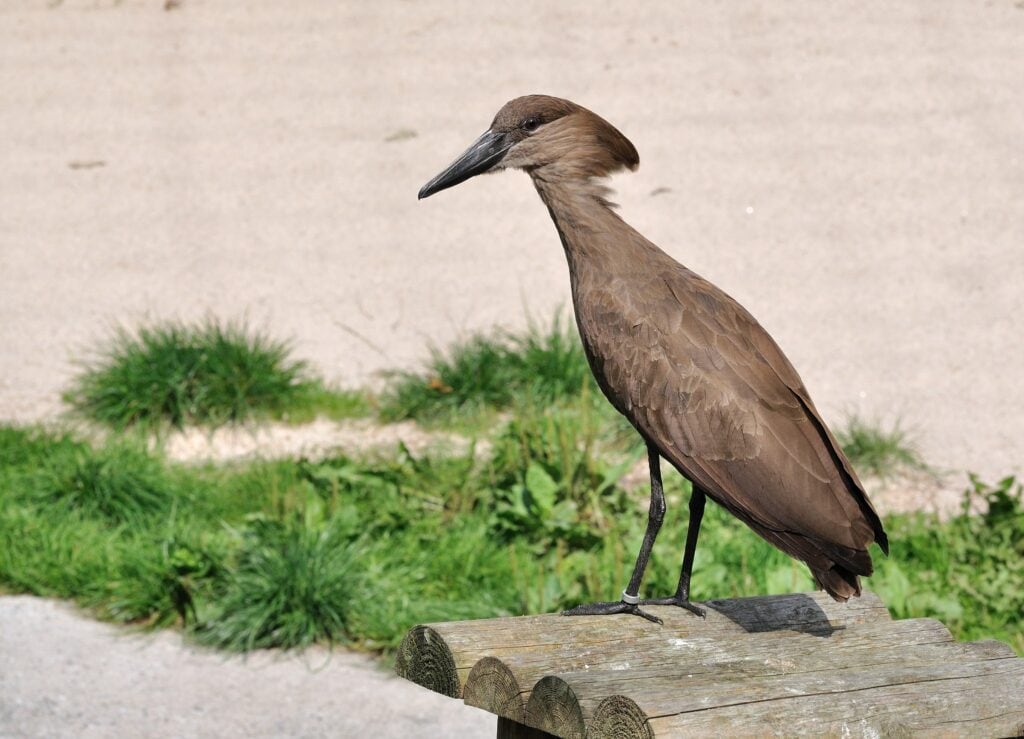
On the subject of the Hamerkop’s nest, this marvel of avian architecture is the feature for which these birds are most well-known. Hamerkop nests are enormous basket-shaped structures which are usually built atop forks in trees near bodies of water. Male and female Hamerkops tag-team nest-building and are known to use all manner of building materials, from sticks as large as five feet long, to a range of human debris. From bicycle tires to random ornamental bits of discarded human materials, Hamerkops may have earned their reputation for witchcraft and magic thanks to their tendency to collect man-made objects. (2)
The Hamerkop nest itself is often large enough to support the weight of a human. The structure is built from sticks and debris, but it is held together and insulated with mud. Nest-building is such an important part of life for Hamerkops that mated pairs will compulsively build nests, even when they are not breeding. Often, Hamerkop nests are co-opted by other species which are drawn to the size and safe insulation of the structure. From hawks to pigeons, the Hamerkop’s nest is a hot piece of real estate.
One of the reasons why Hamerkop nests are so incredible is because they need to be. Hamerkop parents often leave their nestlings for much longer stretches of time than similar wading birds do. The safety and insulation of their nests gives them the freedom to both go out and hunt for frogs or fish to bring home to their young. Plenty of food means strong healthy Hamerkop chicks who can grow up to build impressive nests of their own. (3)
Hamerkops may be associated with carpentry or construction. Their abilities as builders are truly remarkable. Furthermore, the lifestyle of the Hamerkop is a fantastic symbol of the strength and protection of the family. A strong foundation of trust and responsibility is the backbone of a strong family. Hamerkop parents dedicate themselves to building a home that is safe and comfortable for their offspring. For this reason, Hamerkops represent protection, parenthood, the home, and family ties.
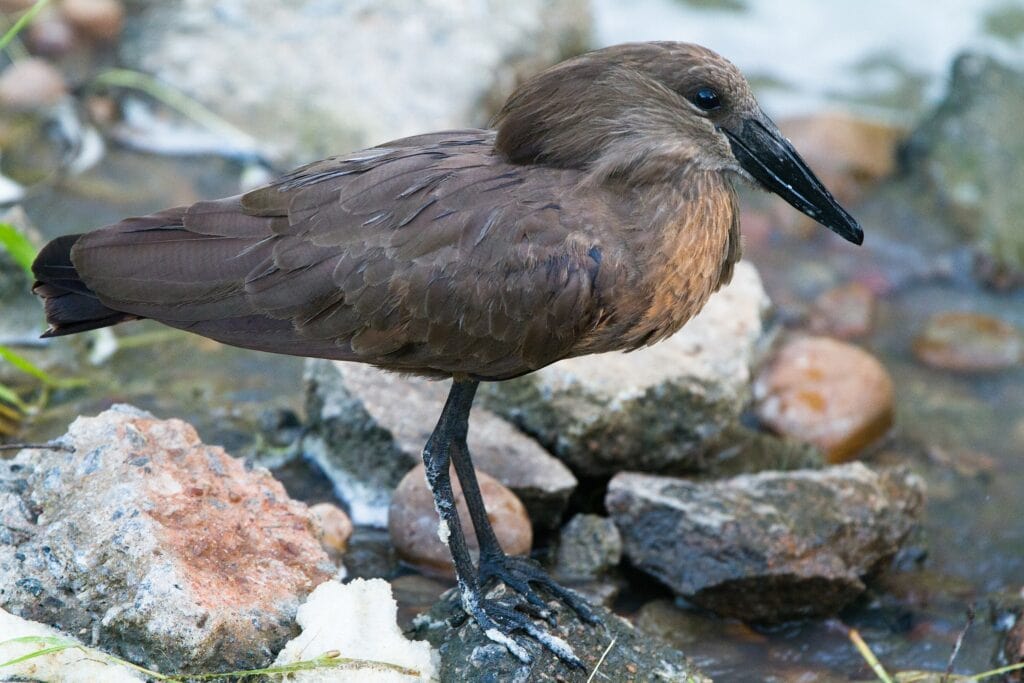
Hamerkops hunt for small amphibians, like frogs and tadpoles, by stirring up mud with their feet as they wade through shallow waters. This strategy may associate these birds with ingenuity, patience, or wisdom. The Hamerkop is not the fastest or the strongest hunter, but it uses its brain to create unique advantages which allow it to thrive.
Hamerkop Native American Symbolism
The Hamerkop is not found in North America and is, thus, not found in Native American mythological or symbolic traditions. There is, however, one connection that can be drawn between the Hamerkop and Native American cultures. This is the Thunderbird. Several Native American tribes share in common a myth of a gigantic bird with dominion over storms and weather phenomena. The sound of thunder is often said to be the beating of the Thunderbird’s powerful wings. While this doesn’t line up with the Hamerkop exactly, it is interesting that these birds are also thought of as bringers of extreme weather. Just as the wings of the Thunderbird are said to bring thunder to the sky, the Hamerkop’s wrath is said to be responsible for lightning strikes. (4)
Hamerkop Christianity Symbolism
The Hamerkop is, predictably, not a major player in the Bible, nor does it often appear in biblical symbolism or iconography. Nevertheless, there are still connections that can be drawn between the Hamerkop and the Christian faith. The Bible has much to say about the sanctity of the home and the importance of a good foundation.
“Through wisdom is a house built; and by understanding it is established: And by knowledge shall the chambers be filled with all precious and pleasant riches.”
— Proverbs 24:3-4 (5)
Connecting the Hamerkop to this passage, as well as other biblical quotes regarding the home, allows this bird to act as a reminder of the importance of humility and spiritual resolve. The Bible treats these virtues as the building blocks of a stable and healthy home.
Hamerkop Celtic Symbolism
Celtic symbolism tends to connect bird with the supernatural realm of the Otherworld. The Hamerkop is not found in the Celtic world, however its dome-like nests could be connected to the mounds which appear in many Celtic myths and fairytales. In Celtic mythology, mounds are transition points between our world and the Otherworld. Magical and unexplainable things are often described as occurring at mounds.
Hamerkop in Dreams
Dreaming of the Hamerkop may refer to the home or the family. Hamerkops are so deeply connected with their impressive nests that dreaming of one may refer to the state of the dreamer’s own home. Dreaming of a Hamerkop family refers to a home life that is stable and satisfying. Dreaming of an empty Hamerkop nest may indicate that one feels unsafe or insecure within one’s home.
Dreaming of a Hamerkop without a nest may refer to the desire for one’s own space. Such a dream may indicate that the dreamer feels vulnerable or is wanting for privacy.
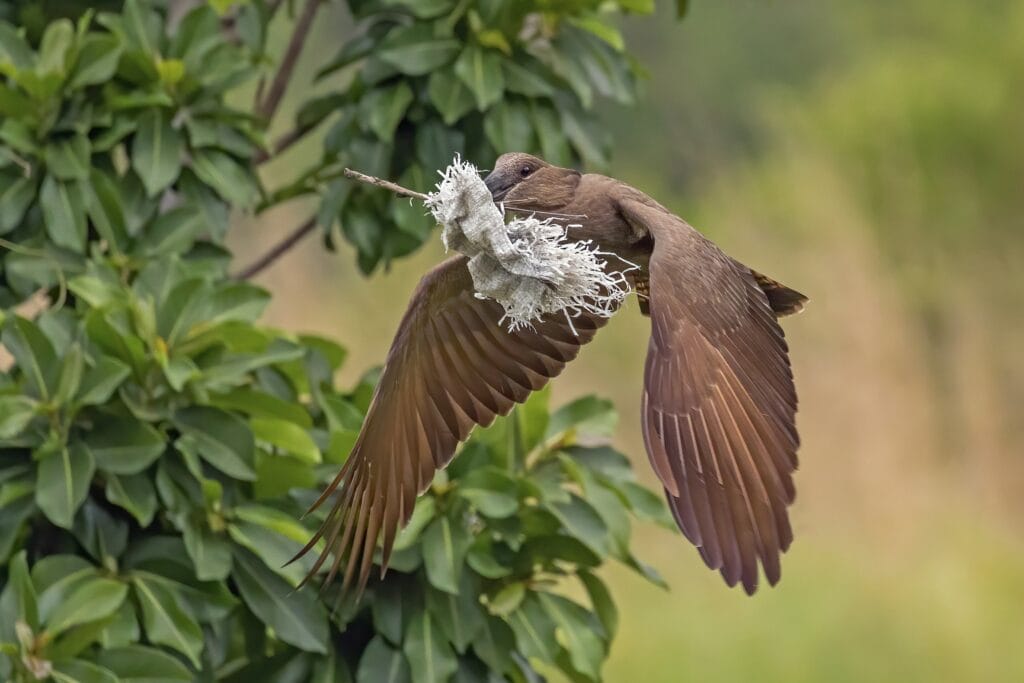
Dreaming of taking an item from a Hamerkop’s nest refers to guilt and consequences. This dream may indicate that the dreamer feels extreme remorse for a past wrongdoing. The dreamer may recognize their wrong actions but still fear the consequences that come with taking responsibility. Such a dream may be a reminder that one cannot run away from one’s own conscience.
Hamerkop Encounters and Omens
Encounters with Hamerkops are sometimes thought of as negative omens which may foretell death or suffering. In many cases, though, such encounters merely provide us with an opportunity to learn from the animals with which we share our environment. In the case of the Hamerkop, for example, discovering a nest may be a poignant reminder of the impact that humans have on the earth’s wild habitats and their animals. Hamerkop nests are often decorated with human litter. Such a sight is a great reminder that many of the objects that we discard become hazardous parts of the environments of delicate wildlife.
A Hamerkop encounter may also be a great reminder to rely on one’s own ingenuity. Watching a Hamerkop stir up mud to hunt is a lesson in utilizing one’s own talents. The Hamerkop does not need to rely on brawn when it plays to its natural strengths.
Hamerkop in Mythology & Folklore
Hamerkops are prevalent in African mythology and are often associated with witchcraft and omens.
African Mythology:
In African mythology, it is said that anyone who raids the nest of a Hamerkop will be struck by lightning. This is just one facet of the myth of the “Lightning Bird.” According to legend, the Lightning Bird lays its eggs in places where lightning has previously struck. It is thought of as a malicious supernatural creatures which feasts upon human blood and consorts with witches and black magicians. The Lightning Bird is also referred to as “Impundulu.” The fearsome Impundulu is said to be the familiar of witches which is passed down through the family line. This supernatural bird is thought to outlive its masters thanks to its vampire-like ability to subsist forever on human blood. The fat of the Impundulu is used as a remedy and is thought to be capable of helping witch doctors catch thieves. (6)(7)

Hamerkop Spirit Animal
If your spirit animal is the Hamerkop then you are likely a true homebody. The Hamerkop spirit animal puts great stock into building and maintaining a safe and comfortable home. People with the Hamerkop as their spirit animal often take great pride in being the person that others can rely on to feel safe and secure. The Hamerkop spirit animal is a fantastic confidante who understands the importance of listening and knows how to keep a secret.
People with the Hamerkop as their spirit animal are often very family-oriented. The Hamerkop spirit animal desires nothing more than to build a safe and cozy home and to fill that home with happy healthy family members. The Hamerkop spirit animal is romantic and prone to dreaming about the future.
Hamerkop Totem Animal
The Hamerkop totem animal represents creativity and constructivity. People with the Hamerkop as their totem animal feel a natural curiosity about the world around them. This curiosity fuels an innate drive to build things. The Hamerkop totem animal is extremely creative and loves seeing their inner vision manifested as reality. Artists, architects, carpenters and builders are all careers that suit the Hamerkop totem animal very well.
If your totem animal is the Hamerkop, try to find new ways to learn about your environment in a hands on way. The Hamerkop doesn’t learn by watching, it learns by building something of its own. Satisfy and feed your curiosity and you may just find that it will bloom into new and unexpected talents and passions.
Hamerkop Power Animal
The Hammerkop power animal is a powerful source of protection and security. The Hamerkop’s nest is the ultimate protective home. It is so protective, in fact, that myths indicate that violating it will result in instantaneous and deadly punishment for the culprit. While this may not be the case in reality, the Hamerkop’s nest is impressively secure. Hamerkop chicks are even able to spend much more time alone than most birds. Their parents are able to go out hunting for food and provide for them thanks to the incredible safety and security that the nest provides.
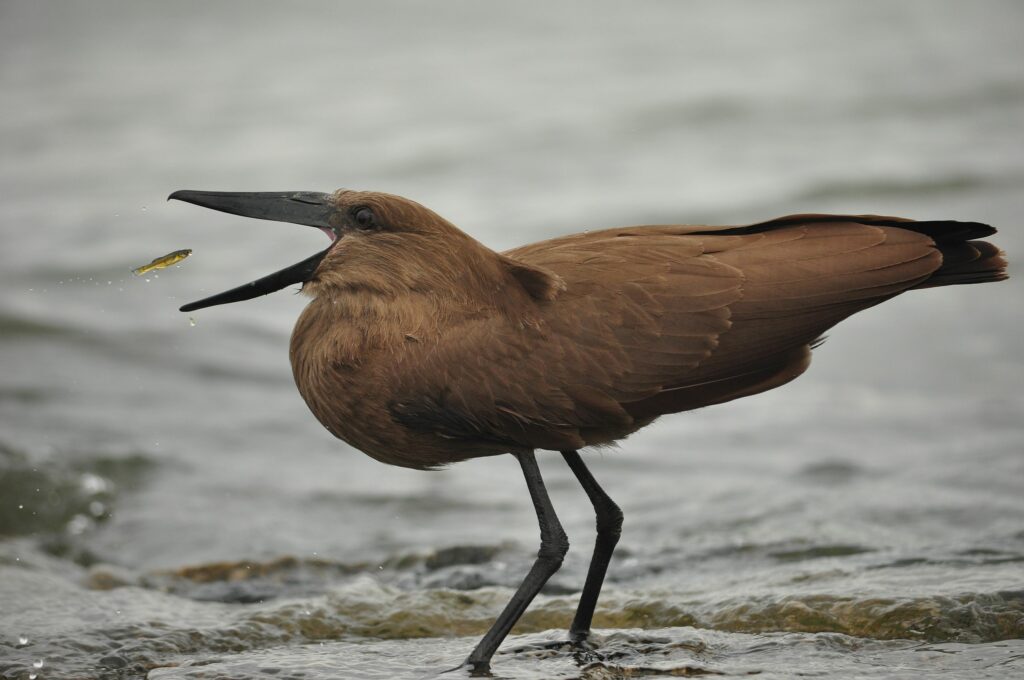
Hamerkop Tattoo Meaning
A Hamerkop tattoo may symbolize one’s home or the place where one feels safest. It may also symbolize family bonds and the relationship between children and their parents.
In some cases, a Hamerkop tattoo may be chosen to represent the fearsome Lightning Bird. Such a tattoo may represent the inviolable sanctity of the home, or the menacing myths connected with this bird. A Lightning tattoo may be connected with bad luck, death, or vampirism.
Conclusion
The Hamerkop may not be the first animal that comes to mind when you think of a cozy home or a gifted architect, but hopefully after reading this article, you’ve found a new appreciation for these unique wading birds and the incredible nests which they construct. The Hamerkop is a fantastic reminder of what an incredible gift a home is, no matter the shape, size, or location it comes in. Hamerkops remind us to appreciate the very special relationships which take a pile of sticks and mud and turn them into a true nest.

